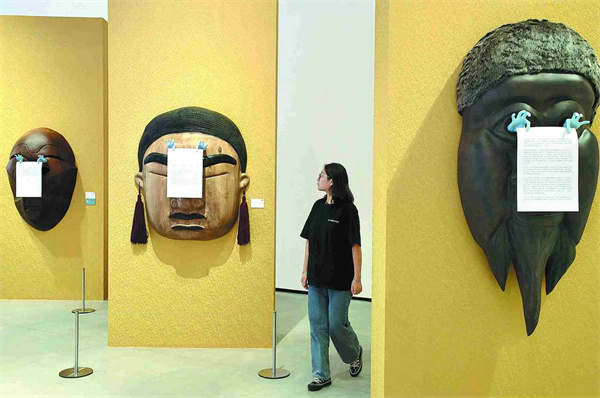A capital idea sees Beijing share its growth

A visitor views an exhibition at the 798 Art District in Beijing. ZHANG WEI/CHINA DAILY
Development of regional hub allows for high-tech development, innovative industries
Only eight years ago, what is today a high-tech innovation zone and finance center in Beijing's Xicheng district was better known as the capital's biggest clothing market and a bus hub near the city zoo.
In 2015, as Beijing started to change its development path, thousands of clothing shops began emptying in the market, which officially closed two years later. Since then the district has been flooded with companies operating in the culture, finance and technology sectors.
"It's hard to imagine that this place was once a wholesale clothing market and the bus hub for Beijing Zoo," said Li Qian, general manager of New Power Jinke Asset Operation Management Co, which manages properties in the area.
"Now, it has been upgraded to a new generation of smart city complexes. You can feel a strong presence of modern science and technology here," Li said.
Finance and science meetings and forums, and news conferences are now regularly held in the district, the company said.
The transformation of Beijing from an industrial city to a modern capital in less than a decade has been achieved in conjunction with the development of the regional cluster.
The coordinated development strategy for Beijing, Tianjin and Hebei province was proposed by President Xi Jinping at a meeting on Feb 26, 2014, after his inspection tour of the capital.
The national-level strategy aimed to coordinate the development of Beijing, Tianjin and Hebei to create the model for a better economic structure, cleaner environment and improved public services. Two "new wings" of the hub — Beijing's subcenter in Tongzhou district and the Xiong'an New Area in Hebei, have also been established to realize this goal.

The New Actuation Fintech Center in Beijing's Xicheng district has been built on the site of a former wholesale clothing market. ZHANG WEI/CHINA DAILY
Less is more
Since then, Beijing has made efforts to get rid of or relocate functions not essential to its role as the national capital through collaboration with Tianjin and Hebei.
Nearly 3,000 manufacturing enterprises have been shifted from Beijing, and 1,000 regional markets and logistics centers were either removed or upgraded, according to the Beijing Municipal Commission of Development and Reform.
Over 7,700 convenience service outlets opened citywide during this period, an indication of the capital's new direction.
Under the guidance of the national-level strategy, Beijing also became China's first megacity, a metropolis with a population exceeding 10 million, to achieve sustainable economic growth while consuming fewer resources.
The permanent population of the city's major urban districts has declined by 15 percent since 2014. By strictly controlling construction in urban and rural areas, the city's built-up areas have been reduced by 120 square kilometers, said the Beijing Municipal Commission of Development and Reform.
Even though the population has been reduced and less land allocated for construction, the capital's economic growth has steadily increased.
In 2021, Beijing's GDP passed the 4 trillion yuan ($570 billion) mark for the first time, with a year-on-year increase of 8.5 percent. Even with the impact of the COVID-19 pandemic, the city's GDP recorded a slight increase last year to reach 4.16 trillion yuan.
Beijing's GDP for the first half of this year was 2.06 trillion, with year-on-year growth of 5.5 percent. The city government said it expects the upward growth trend to continue.

The New Actuation Fintech Center in Beijing's Xicheng district has been built on the site of a former wholesale clothing market. ZHANG WEI/CHINA DAILY
Aiming to improve
In May this year, after an inspection tour in Hebei, President Xi called for more efforts to reach new heights in the coordinated development of the Beijing-Tianjin-Hebei regional hub and to make it a pioneer, and example, in pursuing Chinese modernization.
He called on Hebei to focus on the primary task of high-quality development. The province's strategic task is to create a new development pattern to accelerate building the province into an economic powerhouse with a sound environment, he said.
Xi also called for greater efforts to relieve Beijing of functions nonessential to its role as the nation's capital. He urged planning to start for the relocation of the headquarters of centrally administered State-owned enterprises and their subsidiary companies and innovation units to Xiong'an.
Greater progress was also urged on developing the Beijing municipal administrative sub center in Tongzhou, as well as Xiong'an New Area to effectively rid the capital of its "big city malaise".
On July 20, Beijing, Tianjin and Hebei announced the establishment of a joint working office to promote their coordinated development.
The joint working office sent a signal that cooperation between the three places will be strengthened, shifting from coordination to integration.
Xia Linmao, a member of the Beijing municipal standing committee and executive vice mayor, said the office will oversee the implementation of coordinated development tasks and also advance work tasks.
Key issues include the high-standard construction of Xiong'an New Area and Beijing's Tongzhou district. The high-quality development of three major counties in Hebei province is also high on the agenda.

Workers make final touches to the Beijing Art Center under construction in the capital's sub center Tongzhou district. HAO JIANWEI/XINHUA
Sharing the load
The growth of both Xiong'an and Tongzhou has helped in shifting many of the old industries and administrative functions away from Beijing.
As of January, centrally administered State-owned enterprises had moved more than 140 subsidiaries and branches to Xiong'an, with more enterprises expected to be relocated, according to the Hebei provincial government.
Relocation of more of Beijing's administrative institutions and enterprises to Tongzhou is also due to be accelerated.
Beijing has always supported the construction of Xiong'an New Area and has provided resources to build schools and hospitals.
Three school projects supported by Beijing have been completed and are due to open in September. A hospital project is due to be finished the same month.
Yu Pengbin, secretary of the party committee of Xiong'an Campus of Beijing No.4 Middle School, said the school adheres to the teaching philosophy of its namesake in Beijing, and it will provide advanced education for local students.
The high-quality construction of Beijing's sub center in Tongzhou is also advancing well with 100 billion yuan in annual investment over the past three years, said Hu Jiulong, deputy director of the city's sub center management committee.
Government data shows that the combined GDP of Beijing, Tianjin and Hebei surpassed 10 trillion yuan in 2022, which is 1.8 times the amount in 2013.
Meanwhile, businesses and research efforts in the science and technology innovation sector have also been steadily moved from Beijing to the two other areas.
The number of technology contracts exported from Beijing to Tianjin and Hebei increased from 3,176 in 2013 to 5,881 in 2022, with an average annual growth rate of 7.1 percent, said Zhou Jingwei, an official from the Beijing Municipal Science and Technology Commission.
The next step in collaboration on innovation will focus on improving the efficiency of scientific and technological achievements in the region, Zhou said.
New ways to collaborate on innovation between industries and academic institutions will also be looked at to promote research cooperation in the regional hub, he added.

The Beijing Grand Canal Museum is also being built in the sub center. HAO JIANWEI/XINHUA
Transport access
The Beijing-Tianjin-Hebei region has also made remarkable achievements in transportation integration in recent years. Among them is the establishment of a "one-hour commuting circle" between four cities-Beijing, Xiong'an, Tianjin and Baoding in Hebei.
In the railway sector, the Beijing-Zhangjiakou high-speed railway and the Beijing-Xiong'an intercity railway have also been put into operation. The total railway length in the region is now 1,352 kilometers.
Meanwhile, national highways and urban roads in Beijing have been connected to 68 highways in Tianjin and Hebei, with a total road length of 22,363 kilometers.
"The implementation rate of planned roads has reached 96.6 percent, which has significantly enhanced the city's transportation capacity to radiate to the outside world," said Rong Jun, deputy director of the Beijing Municipal Commission of Transport.
To address the commuting challenges faced by residents in three northern counties of Langfang, Hebei, who work in Beijing, shuttle buses to the capital have been introduced.
The buses operate 107 trips a day and transport over 4,200 passengers. During peak hours, the buses save commuters up to 30 minutes in travel time compared with traveling by car.
Rong said further research will be conducted on whether to extend the bus service to Wuqing and Gu'an, two other cities in Hebei. At present, 38 inter-provincial bus routes operate every day, with average daily passenger volume exceeding 180,000.
Zhang Zhixing, a 38-year-old Langfang resident who works at a company in Beijing's Chaoyang district, said he takes the shuttle bus every workday.
"I used to spend two hours or more on my way to work by car or other public transportation. It was tough," he said.
"I have more time for my family now after I started taking the shuttle bus earlier this year."

 Responsibilities of the SOCAAC
Responsibilities of the SOCAAC Experiencing Beijing 2023
Experiencing Beijing 2023